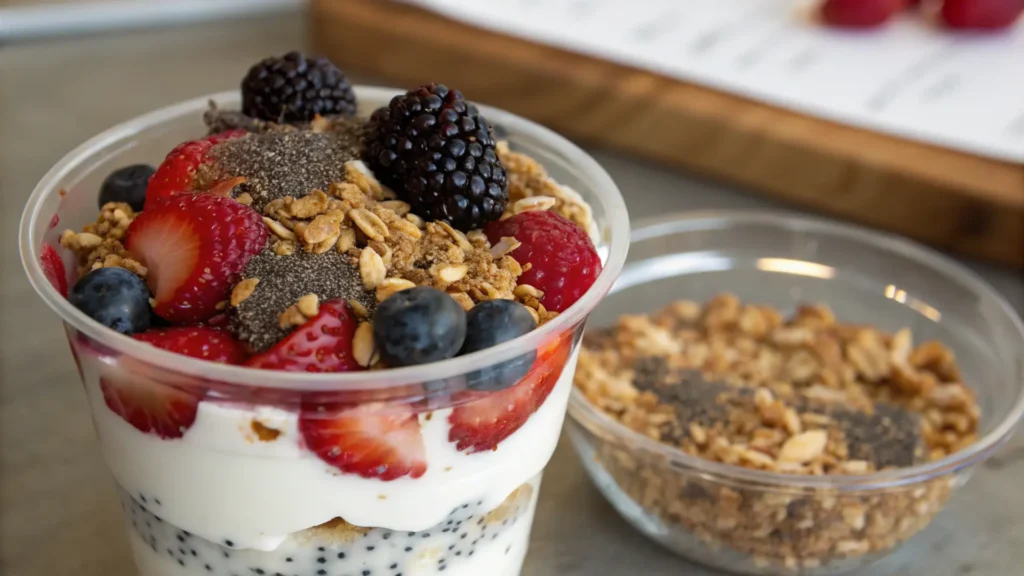Starting your day with a protein packed breakfasts is not just a trend; it’s a necessity for maintaining energy levels and promoting overall health. Protein-rich breakfasts can help you feel fuller for longer, stabilize blood sugar levels, and provide essential nutrients needed for optimal performance throughout the day. In this article, we will explore various protein-packed breakfast options, focusing on eggs, dairy, and plant-based sources. You will also find detailed recipes, tips, and answers to common questions about incorporating protein into your morning routine.
Table of Contents
What Makes a Breakfast Protein-Packed?
A protein-packed breakfast typically includes foods that are high in protein, such as eggs, yogurt, nuts, and legumes. These foods not only provide the body with energy but also support muscle repair and growth. Eating a breakfast rich in protein can help you maintain a healthy weight by keeping you satisfied and reducing cravings later in the day.
Benefits of Protein in Breakfast
Including protein in your breakfast offers numerous benefits. Research shows that protein can enhance feelings of fullness, which may lead to reduced calorie intake throughout the day. Additionally, protein helps to stabilize blood sugar levels, preventing the spikes and crashes that can lead to fatigue and irritability. Therefore, opting for a protein-rich breakfast can set a positive tone for the rest of your day.
Moreover, protein is essential for various bodily functions. It aids in the repair of tissues, supports immune function, and contributes to hormone production. For instance, consuming a protein-packed breakfast can help you recover faster if you engage in regular exercise. This recovery is crucial for muscle growth and overall fitness.
Healthy Ways to Eat Eggs
Eggs are one of the most versatile and nutrient-dense foods you can include in your breakfast. They are an excellent source of high-quality protein, containing all nine essential amino acids. However, how you prepare your eggs can significantly impact their health benefits.
Healthiest Way to Cook Eggs
When cooking eggs, methods such as poaching, boiling, or scrambling with minimal oil are considered the healthiest options. Poached eggs retain most of their nutrients and have no added fats. Boiled eggs are also a great choice, as they are easy to prepare and can be made in batches. Scrambling eggs with a small amount of olive oil or butter can add flavor without significantly increasing calories.
Additionally, consider using non-stick cookware to reduce the need for added fats. This method not only keeps the eggs healthier but also makes cleanup easier.

What to Add to Eggs for Health
To enhance the nutritional value of your eggs, consider adding vegetables like spinach, tomatoes, or bell peppers. These additions not only increase the fiber content but also provide essential vitamins and minerals. For example, spinach is rich in iron, which is vital for energy production, while tomatoes offer antioxidants that support heart health.
Additionally, incorporating herbs and spices can elevate the flavor without adding extra calories. For instance, adding fresh basil or oregano can transform a simple scrambled egg dish into a gourmet meal.
For those looking for a more substantial meal, consider combining eggs with whole grains such as quinoa or whole-grain toast. This combination provides a balanced meal that includes carbohydrates, protein, and healthy fats. You might even try making an egg and quinoa breakfast bowl topped with avocado and salsa for a flavorful twist.
The Role of Eggs in a Protein-Packed Breakfast
Eggs are a staple in many cultures and for good reason. They are incredibly versatile and can be used in various dishes, from omelets to frittatas.
Nutritional Profile of Eggs
One large egg contains about 6 grams of protein, along with essential nutrients such as vitamin D, B12, and selenium. The yolk contains healthy fats and fat-soluble vitamins, making it an important part of the egg. Therefore, including the yolk in your meals is beneficial for overall health.
Furthermore, eggs are relatively low in calories, making them an excellent choice for those looking to manage their weight. With only about 70 calories per egg, they provide substantial nutrition without excessive caloric intake.
Is it Healthy to Eat 5 Eggs a Day?
The debate around egg consumption often centers on cholesterol levels. While eggs do contain cholesterol, recent studies have shown that for most people, eating eggs in moderation does not significantly impact blood cholesterol levels. However, consuming five eggs a day may not be necessary for everyone and could lead to excessive calorie intake. It’s essential to balance your diet with various protein sources to ensure you are meeting your nutritional needs.
For instance, if you enjoy eggs, consider varying your breakfast proteins throughout the week. You might have eggs one day, Greek yogurt the next, and perhaps a smoothie with plant-based protein powder on another day. This approach not only keeps your meals interesting but also ensures a wider range of nutrients.
Other Protein Sources for Breakfast
While eggs are an excellent source of protein, they are not the only option available. Incorporating a variety of protein sources into your breakfast can help you meet your daily requirements.
Dairy Products
Dairy products like Greek yogurt and cottage cheese are excellent sources of protein. Greek yogurt, in particular, contains about 20 grams of protein per cup and is rich in probiotics, which support gut health. You can enjoy Greek yogurt with fresh fruits, nuts, or a drizzle of honey for a delicious and nutritious breakfast.
Additionally, cottage cheese is another fantastic option. It is creamy, versatile, and can be paired with both sweet and savory toppings. For a sweet breakfast, try mixing cottage cheese with pineapple or berries. Alternatively, for a savory twist, add sliced cucumbers and a sprinkle of salt.
Plant-Based Proteins
For those following a vegan or vegetarian diet, there are plenty of plant-based protein options available. Tofu, legumes, and nuts are all excellent choices. Tofu can be scrambled or used in smoothies, while legumes like chickpeas can be added to salads or made into spreads. Nuts and seeds are great for snacking or can be sprinkled on top of oatmeal or yogurt for added crunch and nutrition.
When incorporating plant-based proteins, consider preparing overnight oats with almond milk, chia seeds, and your favorite fruits. This meal is not only high in protein but also rich in fiber, making it a filling option for breakfast.
Ingredients and Instructions
To help you get started on your protein-packed breakfast journey, here’s a simple recipe for a delicious and nutritious breakfast bowl.
Ingredients List
| Ingredient | Amount | Notes |
|---|---|---|
| Eggs | 2 large | Fresh or organic |
| Avocado | 1 medium | Sliced |
| Cherry Tomatoes | 1/2 cup | Halved |
| Spinach | 1 cup | Fresh |
| Olive Oil | 1 tsp | For cooking |
| Whole Grain Bread | 1 slice | Toasted |
| Salt & Pepper | To taste | For seasoning |
Instructions
- Prep the Ingredients: Start by washing and slicing the cherry tomatoes and avocado. Rinse the spinach under cold water and set aside.
- Cook the Eggs: Heat olive oil in a non-stick skillet over medium heat. Crack the eggs into the skillet and cook to your preference (poached, scrambled, or sunny-side-up).
- Toast the Bread: While the eggs are cooking, toast the slice of whole grain bread until golden brown.
- Assemble the Bowl: Once the eggs are cooked, place them on the toast. Add the sliced avocado, cherry tomatoes, and fresh spinach on the side.
- Season: Sprinkle salt and pepper to taste. Enjoy your protein-packed breakfast!


Common Mistakes to Avoid
When preparing protein-packed breakfasts, there are common mistakes that can hinder your health goals. One common pitfall is choosing low-protein options that are high in sugar, such as sugary cereals or pastries. Instead, opt for whole foods that provide both protein and fiber to keep you satisfied.
Another mistake is overlooking the importance of balance. While protein is essential, it’s equally important to include healthy fats and carbohydrates in your breakfast. This balance will help you maintain energy levels and prevent hunger pangs before lunchtime.
For example, if you typically have a protein shake, consider adding a banana or some oats to it. This addition will provide you with carbohydrates that fuel your body, ensuring you have sustained energy throughout the morning.
Incorporating protein-packed breakfasts into your daily routine can significantly impact your overall health and energy levels. By exploring various protein sources, such as eggs, dairy, and plant-based options, you can create delicious and nutritious meals that keep you satisfied throughout the day.
How to Make Protein Packed Breakfasts Step-by-Step
Continuing from where we left off, let’s dive deeper into the delicious world of protein-packed breakfasts. These meals not only satisfy your hunger but also provide essential nutrients to kickstart your day. By incorporating a variety of ingredients and cooking methods, you can create breakfasts that are both nutritious and enjoyable.
Recipe 1: Savory Vegetable Omelet
The savory vegetable omelet is a classic breakfast option that allows for endless customization. It not only provides a good amount of protein but also packs in vitamins and minerals from the vegetables.
Ingredients
| Ingredient | Amount | Notes |
|---|---|---|
| Eggs | 3 large | Fresh or organic |
| Bell Pepper | 1/2 cup | Chopped |
| Onion | 1/4 cup | Chopped |
| Spinach | 1 cup | Fresh |
| Cheese | 1/4 cup | Grated (optional) |
| Olive Oil | 1 tbsp | For cooking |
| Salt & Pepper | To taste | For seasoning |
Instructions
- Prepare the Vegetables: Start by chopping the bell pepper and onion. Rinse the spinach under cold water and set it aside. Preparing your ingredients ahead of time makes the cooking process smoother.
- Cook the Vegetables: Heat olive oil in a non-stick skillet over medium heat. Add the onion and bell pepper, cooking until they soften. This usually takes about 3-4 minutes. Cooking the vegetables first enhances their flavors.
- Add Spinach: Stir in the spinach and cook until wilted, which should take about 1-2 minutes. Spinach adds a vibrant color and a wealth of nutrients to the dish.
- Whisk the Eggs: In a bowl, whisk the eggs with salt and pepper until well combined. Whisking incorporates air, making the omelet fluffier.
- Combine and Cook: Pour the egg mixture over the vegetables in the skillet. Cook until the eggs are set, about 5-7 minutes. If desired, sprinkle cheese on top and cover to melt. Covering the skillet helps the cheese melt evenly.
- Serve: Slide the omelet onto a plate, fold it in half, and enjoy! This dish pairs well with whole-grain toast for a balanced meal.

Recipe 2: Greek Yogurt Parfait
Greek yogurt parfaits are not only visually appealing but also incredibly nutritious. They offer a great balance of protein, healthy fats, and carbohydrates, making them an excellent breakfast choice.
Ingredients
| Ingredient | Amount | Notes |
|---|---|---|
| Greek Yogurt | 1 cup | Plain or flavored |
| Granola | 1/4 cup | Low-sugar variety preferred |
| Mixed Berries | 1/2 cup | Fresh or frozen |
| Honey | 1 tbsp | Optional |
| Chia Seeds | 1 tbsp | Optional |
Instructions
- Layer the Ingredients: In a glass or bowl, start with a layer of Greek yogurt at the bottom. This base provides a creamy texture and a rich source of protein.
- Add Granola: Sprinkle granola over the yogurt layer. Granola adds crunch and fiber, making the parfait more satisfying.
- Add Berries: Layer mixed berries on top of the granola. Berries are rich in antioxidants and add natural sweetness.
- Repeat Layers: Continue layering yogurt, granola, and berries until you reach the top. This method creates a visually appealing dish that’s fun to eat.
- Finish with Honey: Drizzle honey on top if desired, and sprinkle chia seeds for added nutrition. Chia seeds are high in omega-3 fatty acids, contributing to heart health.

Pro Tips & Variations
To make your protein-packed breakfasts even more exciting, consider these tips and variations:
- Experiment with Flavors: Try different herbs and spices in your omelet, such as basil or dill, to change the flavor profile. Additionally, you can swap out vegetables based on what you have on hand or what’s in season. For example, zucchini or mushrooms can be great substitutes.
- Add Protein Boosters: For extra protein, consider adding cooked chicken, turkey, or beans to your omelet. This addition can enhance the dish’s nutritional value significantly and make it even more filling.
- Make Ahead: Prepare overnight oats or yogurt parfaits the night before. This method saves time in the morning and ensures you have a healthy breakfast ready to go. Overnight oats can be made by combining oats, yogurt, and your favorite toppings in a jar.
- Serving Suggestions: Pair your Greek yogurt parfait with a slice of whole-grain toast or a piece of fruit for a balanced meal. A banana or apple complements the parfait nicely.
- Incorporate Superfoods: Consider adding superfoods like flaxseeds, hemp seeds, or acai berries to your breakfast. These ingredients are nutrient-dense and can elevate the health benefits of your meal.

Frequently Asked Questions (FAQs)
1. What are some quick protein-packed breakfast ideas?
For quick protein-packed breakfast ideas, consider options like a smoothie with protein powder, overnight oats with Greek yogurt, or a hard-boiled egg with fruit. These meals are easy to prepare and can be made in advance, saving you time in the morning.
2. Can I prepare protein-packed breakfasts in advance?
Absolutely! Many protein-packed breakfasts can be prepared in advance. For example, overnight oats, yogurt parfaits, and egg muffins can be made the night before. This preparation saves time and ensures you have a nutritious meal ready to go.
3. How can I make my breakfast more filling?
To make your breakfast more filling, include a balance of protein, healthy fats, and fiber. For instance, pair eggs with avocado and whole-grain toast. Additionally, incorporating nuts or seeds into your meals can add healthy fats and increase satiety.
4. Are protein-packed breakfasts good for weight loss?
Yes, protein-packed breakfasts can be beneficial for weight loss. They help you feel fuller for longer, which can reduce overall calorie intake throughout the day. Additionally, protein supports muscle maintenance, which is important for a healthy metabolism.
5. How much protein should I include in my breakfast?
Aim for at least 15-30 grams of protein in your breakfast. This amount can vary based on your individual dietary needs and activity level. Incorporating sources like eggs, Greek yogurt, or protein powder can help you reach this goal.
6. Can I use plant-based proteins for breakfast?
Certainly! Plant-based proteins such as tofu, legumes, and nuts are excellent options for breakfast. You can make a tofu scramble, add chickpeas to a breakfast bowl, or enjoy nut butter on whole-grain toast.
7. What are some toppings for protein-packed breakfasts?
Some great toppings for protein-packed breakfasts include nuts, seeds, fresh fruits, and nut butters. Additionally, consider adding spices like cinnamon or nutmeg for extra flavor without added calories.
8. How do I ensure my breakfast is balanced?
To ensure your breakfast is balanced, include a source of protein, healthy fats, and complex carbohydrates. For example, a breakfast bowl with eggs, avocado, and whole-grain toast provides a well-rounded meal.

Protein Packed Breakfasts: Savory Vegetable Omelet
Start your day with a delicious Savory Vegetable Omelet packed with protein and nutrients. This quick and easy breakfast features fluffy eggs combined with fresh bell peppers, onions, and spinach. Customize it with your favorite cheese for an extra creamy texture. Perfect for a nutritious morning boost!
- Total Time: 20 m
- Yield: 1 serving 1x
Ingredients
- 3 large eggs
- 1/2 cup bell pepper, chopped
- 1/4 cup onion, chopped
- 1 cup spinach, fresh
- 1/4 cup cheese, grated (optional)
- 1 tbsp olive oil
- Salt & pepper to taste
Instructions
- Prepare the Vegetables: Chop the bell pepper and onion. Rinse the spinach and set aside.
- Cook the Vegetables: Heat olive oil in a non-stick skillet over medium heat. Add the onion and bell pepper, cooking until softened (about 3-4 minutes).
- Add Spinach: Stir in the spinach and cook until wilted (about 1-2 minutes).
- Whisk the Eggs: In a bowl, whisk the eggs with salt and pepper until well combined.
- Combine and Cook: Pour the egg mixture over the vegetables in the skillet. Cook until the eggs are set (about 5-7 minutes). If desired, sprinkle cheese on top and cover to melt.
- Serve: Slide the omelet onto a plate, fold it in half, and enjoy!
- Prep Time: 10 m
- Cook Time: 10 m
- Category: Breakfast
- Cuisine: American
Nutrition
- Calories: 300
- Fat: 15
- Carbohydrates: 25
- Protein: 20
Keywords: Protein Packed Breakfasts, Savory Vegetable Omelet
Conclusion
Incorporating protein-packed breakfasts into your daily routine can significantly impact your overall health and energy levels. By exploring various protein sources, such as eggs, dairy, and plant-based options, you can create delicious and nutritious meals that keep you satisfied throughout the day. With the right recipes and preparation methods, you can make breakfast a highlight of your day, fueling your body for whatever lies ahead.

